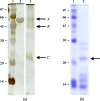Crystallization and preliminary X-ray crystallographic analysis of a GroEL1 fragment from Mycobacterium tuberculosis H37Rv
- PMID: 20383012
- PMCID: PMC2852334
- DOI: 10.1107/S1744309110004409
Crystallization and preliminary X-ray crystallographic analysis of a GroEL1 fragment from Mycobacterium tuberculosis H37Rv
Abstract
Full-length GroEL1 from Mycobacterium tuberculosis H37Rv was cloned, overexpressed and purified. Crystals were obtained by the hanging-drop vapor-diffusion method and contained a 23 kDa GroEL1 fragment. A complete native data set was collected from a single frozen crystal that belonged to the orthorhombic space group P2(1)2(1)2, with unit-cell parameters a = 75.47, b = 78.67, c = 34.89 A, alpha = beta = gamma = 90 degrees , and diffracted to 2.2 A resolution on a home X-ray source.
Figures


Similar articles
-
Purification, crystallization and preliminary X-ray crystallographic studies of Rv3705c from Mycobacterium tuberculosis.Acta Crystallogr F Struct Biol Commun. 2014 Aug;70(Pt 8):1090-2. doi: 10.1107/S2053230X14014113. Epub 2014 Jul 23. Acta Crystallogr F Struct Biol Commun. 2014. PMID: 25084389 Free PMC article.
-
Crystallization and preliminary X-ray analysis of NAD kinase from Mycobacterium tuberculosis H37Rv.Acta Crystallogr D Biol Crystallogr. 2001 Sep;57(Pt 9):1319-20. doi: 10.1107/s0907444901011362. Epub 2001 Aug 23. Acta Crystallogr D Biol Crystallogr. 2001. PMID: 11526331
-
Isolation, purification and preliminary X-ray characterization of Cpn60-2 (65 kDa heat-shock protein) from Mycobacterium tuberculosis.Acta Crystallogr D Biol Crystallogr. 2002 Sep;58(Pt 9):1474-5. doi: 10.1107/S0907444902010909. Epub 2002 Aug 23. Acta Crystallogr D Biol Crystallogr. 2002. PMID: 12198306
-
Crystallization and preliminary X-ray characterization of the glpX-encoded class II fructose-1,6-bisphosphatase from Mycobacterium tuberculosis.Acta Crystallogr Sect F Struct Biol Cryst Commun. 2011 Jun 1;67(Pt 6):710-3. doi: 10.1107/S1744309111014722. Epub 2011 May 26. Acta Crystallogr Sect F Struct Biol Cryst Commun. 2011. PMID: 21636919 Free PMC article.
-
Purification, crystallization and preliminary X-ray crystallographic studies of Rv3899c from Mycobacterium tuberculosis.Acta Crystallogr F Struct Biol Commun. 2015 Jan 1;71(Pt 1):107-9. doi: 10.1107/S2053230X14027228. Epub 2015 Jan 1. Acta Crystallogr F Struct Biol Commun. 2015. PMID: 25615980 Free PMC article.
Cited by
-
Structural and functional conservation of Mycobacterium tuberculosis GroEL paralogs suggests that GroEL1 Is a chaperonin.J Mol Biol. 2011 Jan 21;405(3):831-9. doi: 10.1016/j.jmb.2010.11.021. Epub 2010 Nov 19. J Mol Biol. 2011. PMID: 21094166 Free PMC article.
-
Hsp70 targets Hsp100 chaperones to substrates for protein disaggregation and prion fragmentation.J Cell Biol. 2012 Aug 6;198(3):387-404. doi: 10.1083/jcb.201201074. J Cell Biol. 2012. PMID: 22869599 Free PMC article.
-
Multiple chaperonins in bacteria--novel functions and non-canonical behaviors.Cell Stress Chaperones. 2015 Jul;20(4):555-74. doi: 10.1007/s12192-015-0598-8. Epub 2015 May 20. Cell Stress Chaperones. 2015. PMID: 25986150 Free PMC article. Review.
References
-
- Bartolucci, C., Lamba, D., Grazulis, S., Manakova, E. & Heumann, H. (2005). J. Mol. Biol.354, 940–951. - PubMed
-
- Braig, K., Otwinowski, Z., Hedge, R., Boisvert, D. C., Joachimiak, A., Horwich, A. L. & Sigler, P. B. (1994). Nature (London), 371, 578–586. - PubMed
-
- Collaborative Computational Project, Number 4 (1994). Acta Cryst. D50, 760–763. - PubMed
Publication types
MeSH terms
Substances
Grants and funding
LinkOut - more resources
Full Text Sources

